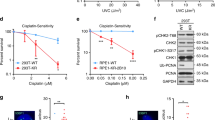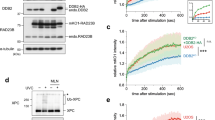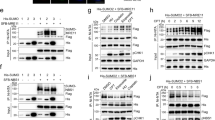Abstract
Protein modification by ubiquitin is emerging as a signal for various biological processes in eukaryotes, including regulated proteolysis, but also for non-degradative functions such as protein localization, DNA repair and regulation of chromatin structure1,2,3,4. A small ubiquitin-related modifier (SUMO) uses a similar conjugation system that sometimes counteracts the effects of ubiquitination5. Ubiquitin and SUMO compete for modification of proliferating cell nuclear antigen (PCNA), an essential processivity factor for DNA replication and repair6. Whereas multi-ubiquitination is mediated by components of the RAD6 pathway and promotes error-free repair, SUMO modification is associated with replication6,7,8,9. Here we show that RAD6-mediated mono-ubiquitination of PCNA activates translesion DNA synthesis by the damage-tolerant polymerases η and ζ in yeast. Moreover, polymerase ζ is differentially affected by mono-ubiquitin and SUMO modification of PCNA. Whereas ubiquitination is required for damage-induced mutagenesis, both SUMO and mono-ubiquitin contribute to spontaneous mutagenesis in the absence of DNA damage. Our findings assign a function to SUMO during S phase and demonstrate how ubiquitin and SUMO, by regulating the accuracy of replication and repair, contribute to overall genomic stability.
This is a preview of subscription content, access via your institution
Access options
Subscribe to this journal
Receive 51 print issues and online access
$199.00 per year
only $3.90 per issue
Buy this article
- Purchase on Springer Link
- Instant access to full article PDF
Prices may be subject to local taxes which are calculated during checkout



Similar content being viewed by others
References
Hershko, A. & Ciechanover, A. The ubiquitin system. Annu. Rev. Biochem. 67, 425–479 (1998)
Hicke, L. Gettin' down with ubiquitin: turning off cell-surface receptors, transporters and channels. Trends Cell Biol. 9, 107–112 (1999)
Conaway, R. C., Brower, C. S. & Conaway, J. W. Emerging roles of ubiquitin in transcription regulation. Science 296, 1254–1258 (2002)
Ulrich, H. D. Degradation or maintenance: actions of the ubiquitin system on eukaryotic chomatin. Eukaryot. Cell 1, 1–10 (2002)
Melchior, F. SUMO—nonclassical ubiquitin. Annu. Rev. Cell Dev. Biol. 16, 591–626 (2000)
Hoege, C., Pfander, B., Moldovan, G. L., Pyrowolakis, G. & Jentsch, S. RAD6-dependent DNA repair is linked to modification of PCNA by ubiquitin and SUMO. Nature 419, 135–141 (2002)
Broomfield, S., Chow, B. L. & Xiao, W. MMS2, encoding a ubiquitin-conjugating-enzyme-like protein, is a member of the yeast error-free postreplication repair pathway. Proc. Natl Acad. Sci. USA 95, 5678–5683 (1998)
Hofmann, R. M. & Pickart, C. M. Noncanonical MMS2-encoded ubiquitin-conjugating enzyme functions in assembly of novel polyubiquitin chains for DNA repair. Cell 96, 645–653 (1999)
Ulrich, H. D. & Jentsch, S. Two RING finger proteins mediate cooperation between ubiquitin-conjugating enzymes in DNA repair. EMBO J. 19, 3388–3397 (2000)
Lawrence, C. W. The RAD6 DNA repair pathway in Saccharomyces cerevisiae: What does it do, and how does it do it? Bioessays 16, 253–258 (1994)
Bailly, V., Lauder, S., Prakash, S. & Prakash, L. Yeast DNA repair proteins Rad6 and Rad18 form a heterodimer that has ubiquitin conjugating, DNA binding, and ATP hydrolytic activities. J. Biol. Chem. 272, 23360–23365 (1997)
Jentsch, S., McGrath, J. P. & Varshavsky, A. The yeast DNA repair gene RAD6 encodes a ubiquitin-conjugating enzyme. Nature 329, 131–134 (1987)
Sung, P., Prakash, S. & Prakash, L. Mutation of cysteine-88 in the Saccharomyces cerevisiae RAD6 protein abolishes its ubiquitin-conjugating activity and its various biological functions. Proc. Natl Acad. Sci. USA 87, 2695–2699 (1990)
Johnson, E. & Gupta, A. A. An E3-like factor that promotes SUMO conjugation to the yeast septins. Cell 106, 735–744 (2001)
McDonald, J. P., Levine, A. S. & Woodgate, R. The Saccharomyces cerevisiae RAD30 gene, a homologue of Escherichia coli dinB and umuC, is DNA damage inducible and functions in a novel error-free postreplication repair mechanism. Genetics 147, 1557–1568 (1997)
Prakash, S. & Prakash, L. Translesion DNA synthesis in eukaryotes: A one- or two-polymerase affair. Genes Dev. 16, 1872–1883 (2002)
Haracska, L., Kondratick, C. M., Unk, I., Prakash, S. & Prakash, L. Interaction with PCNA is essential for yeast DNA Polymerase η function. Mol. Cell 8, 407–415 (2001)
Lawrence, C. W. & Maher, V. M. Mutagenesis in eukaryotes dependent on DNA polymerase zeta and Rev1p. Phil. Trans. R. Soc. Lond. B 356, 41–46 (2001)
Spence, J., Sadis, S., Haas, A. L. & Finley, D. A ubiquitin mutant with specific defects in DNA repair and multiubiquitination. Mol. Cell. Biol. 15, 1265–1273 (1995)
Cassier-Chauvat, C. & Fabre, F. A similar defect in UV-induced mutagenesis conferred by the rad6 and rad18 mutations of Saccharomyces cerevisiae. Mutat Res. 254, 247–253 (1991)
Lawrence, C. W. & Christensen, R. B. UV-mutagenesis in radiation-sensitive strains of yeast. Genetics 82, 207–232 (1976)
Hastings, P. J., Quah, S.-K. & Von Borstel, R. C. Spontaneous mutation by mutagenic repair of spontaneous lesions. Nature 264, 719–722 (1976)
Morrison, A. et al. REV3, a Saccharomyces cerevisiae gene whose function is required for induced mutagenesis, is predicted to encode a non-essential DNA polymerase. J. Bacteriol. 171, 5659–5667 (1989)
Quah, S.-K., Von Borstel, R. C. & Hastings, P. J. The origin of spontaneous mutation in Saccharomyces cerevisiae. Genetics 96, 819–839 (1980)
Brusky, J., Zhu, Y. & Xiao, W. UBC13, a DNA-damage-inducible gene, is a member of the error-free postreplication repair pathway in Saccharomyces cerevisiae. Curr Genet. 37, 168–174 (2000)
Li, S.-J. & Hochstrasser, M. A new protease required for cell-cycle progression in yeast. Nature 398, 246–251 (1999)
Li, S.-J. & Hochstrasser, M. The yeast ULP2 (SMT4) gene encodes a novel protease specific for the ubiquitin-like Smt3 protein. Mol. Cell. Biol. 20, 2367–2377 (2000)
Warbrick, E. The puzzle of PCNA's many partners. Bioessays 22, 997–1006 (2000)
Lea, D. E. & Coulson, C. A. The distribution of the numbers of mutants in bacterial populations. J. Genet. 49, 264–285 (1949)
Von Borstel, R. C. et al. Topical reversion at the HIS1 locus of Saccharomyces cerevisiae: a tale of three mutants. Genetics 148, 1647–1654 (1998)
Acknowledgements
We thank M. Ludwig for technical assistance; R. Viana for construction of the His6-POL30 vector used for the Supplementary Information; M. Hochstrasser for the ulp1ts and ulp2 mutants; C. Hoege and S. Jentsch for the anti-PCNA antibody used for the Supplementary Information; and W. Kramer for comments on the manuscript. R. Kahmann is acknowledged for generous support. H.D.U. is supported by grants from the German Ministry for Education and Research, Deutsche Forschungsgemeinschaft and the German–Israeli Foundation for Scientific Research and Development.
Author information
Authors and Affiliations
Corresponding author
Ethics declarations
Competing interests
The authors declare that they have no competing financial interests.
Rights and permissions
About this article
Cite this article
Stelter, P., Ulrich, H. Control of spontaneous and damage-induced mutagenesis by SUMO and ubiquitin conjugation. Nature 425, 188–191 (2003). https://doi.org/10.1038/nature01965
Received:
Accepted:
Issue Date:
DOI: https://doi.org/10.1038/nature01965
Comments
By submitting a comment you agree to abide by our Terms and Community Guidelines. If you find something abusive or that does not comply with our terms or guidelines please flag it as inappropriate.



